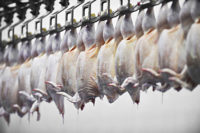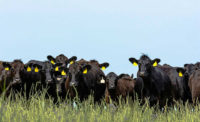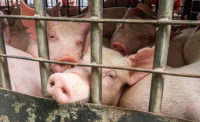The slaughter of livestock hasn’t changed much in 30 years, since Dr. Temple Grandin first proposed small and big changes to the current system and created an Animal Welfare Audit.
Cows still walk through curved loading chutes into a center-track restrainer system, where they are stunned and killed.
“At this stage, much of the innovation effort regarding stunning of red meat species is centered on refinement of methods and equipment,” says Kurt Vogel, Ph.D., assistant professor, University of Wisconsin-River Falls. “As an example, we are starting to see more in-depth research regarding the optimal penetration depth for captive bolt devices.”
In fact, Grandin herself is working on a study exploring the length of the bolt and its effects on stunning with pneumatic captive bolt stunners, says Dale Woerner, assistant professor at Colorado State University, in Fort Collins, Colo.
In January 2016, the Journal of the American Veterinary Medical Association published a report, “Validation of a portable pneumatic captive bolt device as a one-step method of euthanasia for use in depopulation of feedlot cattle,” that showed this device was effective in a clinical trial with few mis-stuns.
“Stunning procedures have been effective for a long time,” says William James, Ph.D., chief consultant, William James & Associates, Dale City, Va. “The increased attention the issue has received from FSIS since 2008 has caused many establishments to pay attention to each animal stunned. No longer do plants try to use a small-gauge stunner effective on a heifer for a bull.”
The most important technological advancement in this area is the availability of better knock boxes, says James.
“There are now some very good boxes out there that confine the animal’s body more securely and fix the head in an excellent stunning position,” he says.
Despite these advancements, mis-stuns are by far the single most common cause of humane handling suspensions by FSIS. “Most of these occur in small establishments, but large establishments are not immune,” James says.
Consequently, Vogel says, “I think we will see more innovation regarding training for stunner operators as time goes on too. The technology is available to design simulation programs that could serve as great training and refresher tools.”
Gas-stunning
Overall, the pork industry has also made minimal changes to its slaughter process.
“But the industry has moved away from electrical stunning to CO2 stunning, because more people say CO2 is more humane,” says Dustin Boler, assistant professor, University of Illinois, Urbana-Champaign. “When properly applied, the electrical method is very humane. But pigs like to move in groups and CO2 can be used as pigs are moved in small groups.”
In addition, with the CO2 or Controlled Atmosphere Stunning method there is less carcass damage (less blood-splash and broken bones) and the overall product quality is higher, says Boler.
In the poultry industry, most birds undergo electrical water bath stunning before slaughter. But Controlled Atmosphere Stunning is growing in popularity, particularly in Europe, because birds aren’t shackled before stunning and their product quality is said to be better, according to “A Review of Different Stunning Methods for Poultry — Animal Welfare Aspects (Stunning Methods for Poultry)” in the Animals open access journal.
A Low Atmosphere Pressure System has also been approved for use in the United States but not Europe. This method lowers the air pressure in a sealed transport container of birds, so they are also not handled or shackled before stunning.
Transcranial Magnetic Stimulation (TMS) and the use of microwave energy are two other emerging stunning methods undergoing experimentation, notes the review. With TMS, a copper coil is placed close to a bird’s skull and then hit with an electric current to stimulate unconsciousness. Microwave energy is being experimented with to apply controlled irradiation to birds’ brains to induce unconsciousness.
Improving food safety
Sanitary dressing remains a critical component of the slaughter process, in which carcasses are handled by establishment employees and machinery in a manner that produces a clean, safe, wholesome product in a sanitary environment, according to FSIS.
“The most important innovations that need to occur at slaughter involve sanitary dressing,” says James, who was a former Chief Public Health Veterinarian in the USDA-FSIS. “It seems to me that there have been few significant advancements in this area in recent years. For instance, I see improved models of interventions like steam vacuums. But, I led the approval process in FSIS for steam vacuums almost 20 years ago.”
Application of various chemical interventions has also been used for a long time now, with better application vehicles now available, James says.
“However, I don’t see anything in the plants I’ve worked in that I’d call a significant step forward,” he says. “Even the New Poultry Inspection System [NPIS] implemented by FSIS was an old idea. The system implemented in 2014 is little changed from what I helped design and develop 10 years ago.”
Until the next big idea is created for slaughter improvements, the beef industry should look more closely at refining pre-harvest interventions, notes James.
FSIS has spearheaded advances in food safety, in part, by focusing more on diseases and conditions related to food safety rather than food quality, as the agency developed new inspection systems throughout the 1980s, 1990s and early 2000s, James says.
“However, foodborne illnesses haven’t declined in a decade,” James says. “It’s time for the industry to step forward.”
The beef industry has had better luck improving worker safety issues, he says.
“The industry pays more attention to ergonomic issues and worker safety issues than when I entered my first slaughter plant in 1983,” says James. “Cumulative trauma disorders are not as common. Job sharing, better tools and improved designs of work stations have helped.”
Automating the butchers
The red meat industry continuously seeks technologies that would make automation a greater possibility, Woerner says.
“This would largely include the development of robotics for slaughter and fabrication processes” to improve worker safety, ergonomics and food safety, Woerner says. “I would also say that companies are trimming high-risk areas of carcasses more extensively to reduce contamination and improve food safety.”
Increased automation in the poultry industry has helped it achieve impressive efficiency, James says.
“Efficiency is on everyone’s mind,” he says. “Livestock slaughter will catch up. New inspection systems by FSIS have increased efficiency for the agency and for industry.” NP
Have meat, will travel
Can slaughter be made more local?
Mobile slaughter units (MSUs), or trailers that go to farms equipped with slaughter equipment, actually preceded today’s locally sourced trends and ethical butcher movement. And they resonate with consumers who don’t want their animals to travel far from farm to table.
Their challenge? They are only capable of slaughtering about eight to 10 cows, 20 pigs or 40 chickens a day, compared with much higher throughput at large-scale, static operations.
“MSUs have been all the rave for the past 10 years, but we have seen very few actual units put into production,” says Dale Woerner, Ph.D., assistant professor at Colorado State University, Fort Collins, Colo. “The issue is that MSUs serve a very small, yet growing, niche market, and they are not inexpensive and they are not exempt from regulatory requirements (from the USDA-FSIS).”
MSUs are meant to serve small family farmers who want to deliver their livestock quickly to consumers, restaurants and local stores, but may have to travel far distances to their nearest USDA-inspected processing facilities.
The trailers contain a diesel generator, water storage, water heater, refrigeration and tools to allow for fully self-contained operation.
“The idea of mobile slaughter units has been attractive to some folks for a long time,” says William James, Ph.D., chief consultant, William James & Associates, Dale City, Va. “The current Secretary of Agriculture fell in love with the concept. But it’s hard to make a living that way. Also, staffing is a problem for FSIS. It’s not likely that there will ever be many mobile slaughter establishments around the country.”
Instead, demand for small, local/regional plants is increasing as consumers continue to desire local products.
“These plants are not mobile in any way, but they serve the local niche markets and retail concepts such as Whole Foods,” Woerner says.
These very small and small establishments face challenges, as well.
“They don’t have the resources to deal with adverse regulatory actions that the big guys have,” says James. “As a result, there are regulatory decisions made in the little plants that would never be made in large plants. However, there are resources available to the little guys at lower cost than hiring a full-time regulatory issues manager,” such as joining a trade association or hiring a consultant with regulatory experience.





Report Abusive Comment